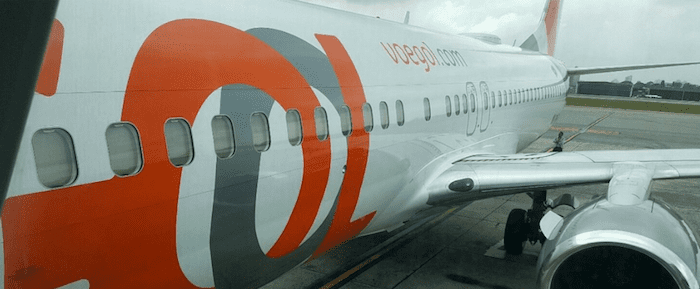
GOL Boeing 737. Photo, courtesy of Gogo.
GOL Linhas Aereas will become the launch partner for Gogo’s aircraft data service, wireless quick access recorder (QAR) and automated turbulence reporting in an effort to bring increased access to real-time flight operational information for the Brazilian airline’s pilots and maintenance technicians.
Under the new partnership, GOL will use Gogo’s 2Ku satellite-based connectivity service to give its pilots real-time graphical weather updates and transmit critical flight data about systems and components to its maintenance technicians. GOL first added Gogo’s 2Ku connectivity to its fleet of Boeing 737-700s and Boeing 737-800s in 2016. The airline has now installed 2Ku across 91 of its 119 in-service 737s and can enable the use of the wireless QAR, automated turbulence and data service with some re-wiring and software updates.
Gogo describes its aircraft data services solution as using onboard aircraft digital flight data acquisition units with active ARINC 717 bi-polar ports transmitting data about aircraft engines, wings and other systems and components to Gogo’s airborne control processor unit (ACPU2). The ACPU2 acquires, records and compresses the 717 data prior to transmitting it to the ground over the 2Ku network. This capability is enabled by ACPU2’s quad-core i7 processors, 2.56 terabytes of solid state drive storage, six MCU ARINC 600 design and 12 different ethernet ports.
Once on the ground, GOL’s ground servers will capture data for analysis by third party FOQA, engine health and aircraft health management applications used by GOL’s data analytics team.

Gogo’s Wireless QAR process. Photo, courtesy of Gogo.
“This solution eliminates the need for expensive media and manual retrieval from the aircraft; ultimately, improving the timeliness of the subsequent analysis,” Chad Gill, Gogo’s head of product management for connected aircraft services told Avionics International.
Gill described the new partnership as a “full fleet deal,” where GOL will be able to make the aircraft data services solution active as soon as the airline’s pilots and maintenance team is ready. The wireless QAR upgrade will require some wiring changes that GOL will work into its fleet “over the next few years,” Gill said.
The new partnership announcement with GOL is the latest example of Gogo’s efforts to provide airlines with technology that allows them to go beyond the use of connectivity for internet access by passengers in aircraft cabins. Delta Air Lines pilots for example, have been using using an EFB application to set threat index alerts from existing avionics sensors installed on their aircraft capable of using algorithms developed by the National Center for Atmospheric Research. The algorithms use a combination of aircraft vertical accelerometer data and atmospheric state data, including aircraft-specific behavioral data such as pitch, roll and wind speed to formulate app-based turbulence reports for pilots using Gogo’s in-flight connectivity network.
“Gogo is rapidly moving beyond passenger connectivity to connect pilots, flight attendants and the aircraft itself so airlines can access real-time information,” said John Wade, president of commercial aviation at Gogo. “GOL has been at the forefront of technology adoption in the aviation industry; now they will be leading the way in leveraging aircraft data to drive efficiency.”
GOL will also be one of many airlines flying with Gogo’s 2ku antenna that will be able to upgrade to lower latency low earth orbit (LEO) satellite connectivity in the future. Gogo CEO Oakleigh Thorne addressed its 2Ku antenna de-icing issues, financial challenges and future business model changes for the company during the company’s second quarter earnings call in August.